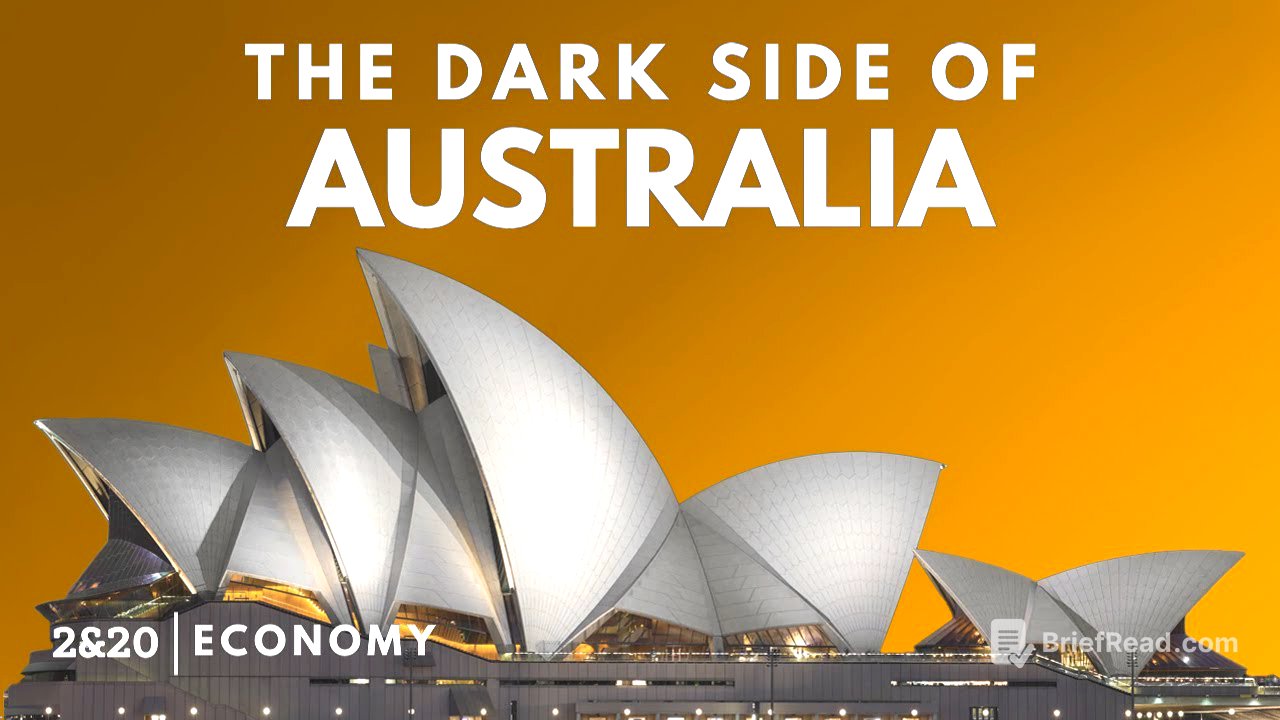TLDR;
This video examines the factors contributing to Australia's housing and rental crisis, which has led to declining wages and increased cost of living. It identifies immigration, insufficient home construction, tax incentives favoring property investment, and declining productivity as key issues. The video concludes that solving this crisis requires incentivizing business investment, reducing income taxes, reforming tax incentives related to property, cutting red tape to boost development, and promoting informed citizenry.
- Housing prices have increased dramatically, making home ownership unattainable for many.
- Immigration and low construction rates exacerbate the housing crisis.
- Tax incentives like negative gearing encourage property speculation.
- Declining productivity and business investment worsen the economic situation.
Intro [0:00]
In 2023, Australia experienced a per capita recession, leading to wage declines not seen since 2011. The primary concern for Australians is the increasing cost of living. Over the past few decades, Australia has undergone a significant housing boom, with house prices increasing 36-fold since 1973 in capital cities, making Sydney one of the most unaffordable cities globally.
Chapter 1: Housing and Rental Crisis [0:49]
Australia is a beautiful place, but it's becoming increasingly difficult to live there. To buy a median home in Melbourne, a family needs to earn at least $170,000 per year, while in Sydney, that number is $260,000. These figures are significantly higher than the median household income in both cities, which is around $100,000. Since 2020, house prices in Brisbane, Adelaide, and Perth have increased by over 50%, while wages have only grown by 12%. Home ownership rates for people under 34 have declined by nearly 25%. Even properties lacking basic amenities like toilets, power, and kitchens are being sold for millions due to bidding wars. Rental rates have also skyrocketed, with median rents in Sydney exceeding $3,000 per month and Brisbane not far behind at $2,500. Since 2020, annual rental rates have increased by over 8% per year. The demand for rental units is extremely high, with dozens or even hundreds of applications for each property.
Chapter 2: Immigration [3:30]
Immigration is often cited as a factor real estate out of control. From 2022 to 2023, Australia welcomed nearly 740,000 people, the highest number in modern Australian history and 200,000 more than pre-COVID levels. This surge in immigration has increased demand for housing, particularly rental properties, as 70% of temporary visa holders are renters. Migrant-heavy suburbs have seen significant rent increases, with some areas experiencing 18% jumps in the last year. Immigrants often share units to save money, increasing competition for locals. However, the argument that immigration is the primary driver of increased housing prices is weaker, as migration rates have decreased over the last decade and align with historical averages.
Chapter 3: Not Building Enough Homes [5:00]
The construction industry faces a dilemma: the cost of building new homes rose again in 2023, resulting in only 170,000 dwellings completed, the lowest amount in a decade, coinciding with the biggest spikes in immigration in a generation. Since 1966, the number of homes built relative to the population has been declining, with a significant drop in building rates around 2000, creating a supply shortage. Australia's suburban culture favors urban sprawl over densification. Australian cities are less densely populated compared to other major Western cities. Strong community advocacy and government red tape lead to long approval times for housing developments. Australia is on track to build 40% fewer homes than needed to meet affordable housing targets. The low rate of approvals for housing has created an artificial land scarcity, driving up land prices.
Chapter 4: Tax Incentives (negative gearing, supers, and capital gains) [8:07]
During the 1930s, Australia introduced negative gearing to encourage investment in rental properties, allowing investors to offset losses on rental properties against their personal income. Only New Zealand and Japan have similar policies within the OECD. In the 1980s, attempts to change negative gearing rules were met with backlash, and the original form was reinstated. The removal of interest rate controls in the 1980s made it cheaper to use debt to buy homes, further incentivizing negative gearing. Real estate investments can be held in retirement accounts (supers), with rental income taxes reduced to 15% instead of the marginal rate. In 1999, the government reduced capital gains on real estate sales by 50%, and if held in a super, the effective tax is only 10%. Australia has one of the most favorable tax regimes for property investors globally. These tax policies have encouraged speculation in real estate, costing taxpayers nearly $8 billion per year.
Chapter 5: Declining Productivity and Investment [10:52]
Australia's favorable conditions for investing in nonproductive assets like real estate have disincentivized investment in other sectors. Productivity growth has been slowing, with average annual labor productivity growth between 2010 and 2020 at only 1.1%. This is partly due to a lack of innovation and growth in non-service and non-mining sectors. Australia's R&D spending as a percentage of GDP was 1.7% in 2022, lower than the OECD average of 2.4%. Nominal GDP per capita and real GDP per capita have not increased over the last ten years. Australia collects a disproportionate amount of government revenue from income and corporate taxes and a disproportionately low amount from real estate.
Chapter 6: The Solution and Conclusion [13:02]
Australia's housing crisis is a long-standing issue beyond political parties. Solving it requires incentivizing business investment, lowering income taxes, abolishing negative gearing, lowering capital gains incentives, removing red tape to encourage development, and educating Australians to hold politicians accountable. The solution involves policy changes to create a fairer economic system.









